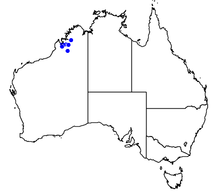Kimberley archerfish
| Toxotes kimberleyensis | |
|---|---|
| Scientific classification | |
| Kingdom: | Animalia |
| Phylum: | Chordata |
| Class: | Actinopterygii |
| Order: | Perciformes |
| Family: | Toxotidae |
| Genus: | Toxotes |
| Species: | T. kimberleyensis |
| Binomial name | |
|
Toxotes kimberleyensis Allen, 2004 | |

| |
| T. kimberleyensis range | |
Toxotes kimberleyensis is a species of archerfish found in the Kimberley region of Western Australia. It was first named by Gerald R. Allen in 2004, and is commonly known as the Kimberley archerfish, largescale archerfish, or western archerfish.
Archerfish are distributed throughout the waters of Australia and Indonesia, including a population in western Australia historically identified as Toxotes oligolepis. In 1978, in his Review of the Archerfishes, Gerald R. Allen suggested that "there is a possibility that [this population] may represent a distinct species". A direct comparison with the type material of T. oligolepis in 2001 revealed the Kimberley specimens differed in several ways, including having a deeper body and shorter dorsal fin spines. The specific name kimberleyensis refers to the Kimberley region of western Australia, where the species is localized.
T. kimberleyensis can be identified from its fins, with five spines and 11–13 soft rays on the dorsal fin, three spines and 14–16 rays on the anal fin, and 12–13 pectoral rays. There are between 28 and 33 scales on the lateral line, which is nearly unbroken except at the pectoral fin. The pelvic fins are short. There are six to seven gill rakers on the lower limb of the first branchial arch.
T. kimberleyensis can reach up to about 12.6 cm (5.0 in) in length, has a large mouth opening at an angle and fine villiform teeth. The head and body are smooth with very fine scales, but the scales are toothed as is common for perciform fish. T. kimberleyensis is silvery or silvery-white in color, with black side markings. The sides of the body are marked with four to five black bars which may be wedge-shaped or rounded. In young specimens, the fins are translucent or transparent, but adults have grey or black fins.
...
Wikipedia
